
Listed buildings in Sheffield
Encyclopedia
There are about 1,000 listed buildings in Sheffield
. Of these only five are Grade I listed, and 42 are Grade II*, the rest being Grade II listed. The buildings vary from a listed facade to the largest listed building in Europe (Park Hill).
The dates given refer to the year(s) of completion.
Sheffield
Sheffield is a city and metropolitan borough of South Yorkshire, England. Its name derives from the River Sheaf, which runs through the city. Historically a part of the West Riding of Yorkshire, and with some of its southern suburbs annexed from Derbyshire, the city has grown from its largely...
. Of these only five are Grade I listed, and 42 are Grade II*, the rest being Grade II listed. The buildings vary from a listed facade to the largest listed building in Europe (Park Hill).
The dates given refer to the year(s) of completion.
Grade I
| Building | Image | Date built | Architect |
|---|---|---|---|
| Abbeydale Industrial Hamlet Abbeydale Industrial Hamlet Abbeydale Industrial Hamlet is an industrial museum in the south of the City of Sheffield, England. The museum forms part of a former steel-working site on the River Sheaf, with a history going back to at least the 13th century... (Works) |
1785–1876 | ||
| Church of St. Nicholas, Bradfield Church of St. Nicholas, Bradfield The Church of St. Nicholas, Bradfield is situated in the small village of High Bradfield which is located north west of the centre of the city of Sheffield in South Yorkshire, England. It is one of only five Grade One Listed buildings in Sheffield... |
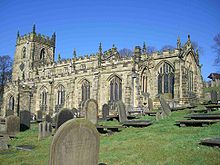 |
c.1200–c.1500 | |
| Church of St. Mary, Ecclesfield Church of St. Mary, Ecclesfield The Church of St. Mary, Ecclesfield is situated on Church Street in the village of Ecclesfield, now a northern suburb of Sheffield, South Yorkshire, England. It is situated seven kilometres north of the city centre. It is a Grade One listed building, one of only five within the Sheffield city... |
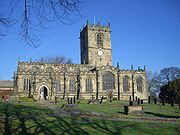 |
c.1200– | |
| Sheffield Cathedral Sheffield Cathedral Sheffield Cathedral is the cathedral church for the Church of England diocese of Sheffield, England. Originally a parish church, it was elevated to cathedral status when the diocese was created in 1914... |
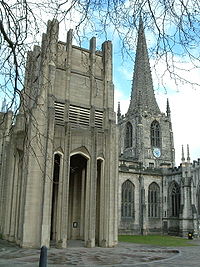 |
1430–1966 | |
| Town Hall Sheffield Town Hall Sheffield Town Hall is a building in the City of Sheffield, England. The building is used by Sheffield City Council, and also contains a publicly displayed collection of silverware. The current building, Sheffield's fourth town hall, is located on Pinstone Street. It was designed by the... |
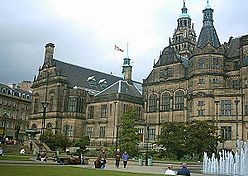 |
1897 | E. W. Mountford |
Grade II*
This is a complete list of all Grade II* listed buildings in Sheffield.| Building | Image | Date built | Architect |
|---|---|---|---|
| Paradise Square, Sheffield | 1736–1771 | ||
| Abbeydale Industrial Hamlet Abbeydale Industrial Hamlet Abbeydale Industrial Hamlet is an industrial museum in the south of the City of Sheffield, England. The museum forms part of a former steel-working site on the River Sheaf, with a history going back to at least the 13th century... (Workers' Cottages, Counting House and Manager's House) |
1785–1876 | ||
| Church of St Thomas a Becket and remains of Beauchief Abbey Beauchief Abbey Beauchief Abbey is a former abbey in Sheffield, England. Beauchief is prounounced bee-chiff.-History:The abbey was founded by Robert FitzRanulf de Alfreton. Thomas Tanner, writing in 1695, stated that it was founded in 1183... |
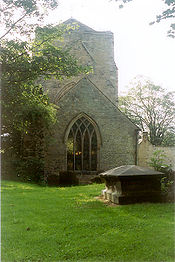 |
1276 or 1283 | Church restored by Edward Pegge |
| Beauchief Hall and adjoining structures | 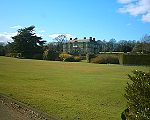 |
||
| Beehive Works Beehive Works The Beehive Works are a purpose built cutlery works located on Milton Street in the Devonshire Quarter area of Sheffield city centre. The works were built in stages in the second half of the 19th century and are designated as a Grade II* listed building with English Heritage stating that they are... |
1850s/60s | ||
| Bishops' House Bishops' House Bishops' House is a half-timbered house in the Norton Lees district of the City of Sheffield, England. It was built c. 1500 and is located at , on the southern tip of Meersbrook Park... |
c. 1500 | John and Geoffrey Blythe | |
| Butchers Wheel Butchers Wheel Butchers Wheel or Butcher Works is a former cutlery and tool factory in Sheffield, South Yorkshire. The last of the manufacturing tenants left in 2004. The building is a listed historic site, and is now used for residential and retail purposes.... |
1820s-1870s | ||
| City Hall Sheffield City Hall Sheffield City Hall is a Grade II* listed building in Sheffield, England, containing several venues, ranging from the Oval Concert Hall which seats over 2,000 people to a ballroom featuring a sprung dance floor... |
1934 | Vincent Harris Vincent Harris Emanuel Vincent Harris OBE, RA was an English architect who designed several important public buildings.He was born in Devonport, Devon and educated at Kingsbridge Grammar School. He was articled to the Plymouth architect James Harvey in 1893; in 1897 he moved to London where he assisted E. Keynes... |
|
| Cornish Place Cornish Place Cornish Place is a Listed building situated in the Neepsend area of the City of Sheffield. The building was formerly the factory of James Dixon & Sons, a Britannia metal, Sheffield plate and Cutlery manufacturer... (East and West Ranges) |
1822–1860 | Built for James Dixon & Sons James Dixon & Sons J Dixon & Sons founded 1806 in Sheffield, was one of the major British manufacturers in the Industrial Revolution of the 19th century... |
|
| Cutlers' Hall Cutlers' Hall Cutlers' Hall is a Grade II* listed building in Sheffield, England that is the headquarters of the Company of Cutlers in Hallamshire. It is located on Church Street opposite Sheffield Cathedral.-History:... |
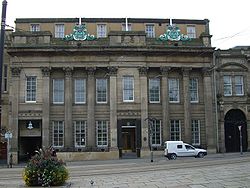 |
1832 | Samuel Worth and B. B. Taylor |
| Ecclesfield Priory Ecclesfield Priory Ecclesfield Priory was a religious house of Benedictine monks, lying in the village of Ecclesfield, north of Sheffield in Yorkshire, United Kingdom.-Early history:... |
 |
c. 1273 | |
| Endcliffe Hall Endcliffe Hall Endcliffe Hall is a 19th century 36 room mansion situated on Endcliffe Vale Road in the City of Sheffield in the suburb of Endcliffe. The hall is situated just over three km west of the city centre and is a Grade II* Listed building.... |
c. 1860 | Built for Sir John Brown John Brown (industrialist) Sir John Brown , British industrialist, was born in Sheffield. He was known as the Father of the South Yorkshire Iron Trade.... |
|
| Fair House Farmhouse Fair House Farmhouse Fair House Farmhouse is a 17th century building situated on Annet Lane in the village of Low Bradfield within the boundary of the City of Sheffield in South Yorkshire, England... , Low Bradfield Low Bradfield Low Bradfield is a village within the in South Yorkshire, England. It is situated within the boundary of the city of Sheffield in the upper part of the Loxley Valley, 6¼ miles west-northwest of the city centre and just inside the northeast boundary of the Peak District National Park... |
1630s | Unknown | |
| Globe Works Globe Works The Globe Works are a former cutlery factory situated in the City of Sheffield, South Yorkshire, England on Penistone Road in the suburb of Neepsend. The Works are a Grade II* Listed Building which in the late 1980s were renovated to provide modern office space... |
1825 | Henry and William Ibbotson | |
| Entrance Gateway to Green Lane Works Green Lane Works The Green Lane Works are a disused industrial facility situated in the City of Sheffield, England. The entrance gate to the works is particularly ornate and has been designated as a Grade II* listed building. Nikolaus Pevsner called the gate “the most spectacular survival of factory architecture in... |
1795 & 1860 | Alfred Stevens Alfred Stevens (sculptor) Alfred Stevens , British sculptor, was born at Blandford Forum in Dorset.He was the son of a house painter and in the early part of his career he painted pictures in his spare time. In 1833, the rector of his parish enabled him to go to Italy, where he spent nine years studying at Naples, Pompeii,... |
|
| Heritage House Sheffield Royal Infirmary The Royal Infirmary was a hospital in Sheffield, South Yorkshire. The establishment opened in 1792 under the name Sheffield General Infirmary, renamed Royal Infirmary in 1897 and closed in 1980.... , Infirmary Road |
 |
1797 | John Rawsthorne John Rawsthorne John Rawsthorne is an English prelate of the Roman Catholic Church, currently serving as Bishop of Hallam.John Rawsthorne was the first son of Harold and Miriam Rawsthorne; he has two brothers, Paul and Christopher, and three sisters, Elizabeth, Ann, and Katherine. After attending St... |
| King Edward VII Upper School Wesley College, Sheffield Wesley College, a school to educate the sons of the laity, opened in 1838 in new buildings designed by William Flockton on Glossop Road, Sheffield, England. It was founded by Rev... |
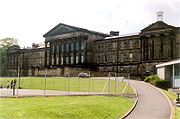 |
1838 | William Flockton William Flockton Flockton's were a series of architectural firms in the 19th and early 20th centuries, based in Sheffield, England. The firms were responsible for a number of significant buildings, particularly in the Sheffield area.-William Flockton:... |
| Leah's Yard Leah's Yard Leah’s Yard is a former collection of small industrial workshops situated on Cambridge Street in the city centre of Sheffield in South Yorkshire, England... , Cambridge Street |
mid-19th century | ||
| Little Matlock Rolling Mill Little Matlock Rolling Mill Little Matlock Rolling Mill also known as Low Matlock Rolling Mill is a Grade II* Listed building situated on the River Loxley in the village of Loxley on the outskirts of the City of Sheffield, South Yorkshire, England. The building continues to operate as a rolling mill, owned and operated by... |
1882 | ||
| Lyceum Theatre Lyceum Theatre (Sheffield) -History:Built in 1897 following a traditional proscenium arch design, the Lyceum is the only surviving theatre outside of London designed by the famous theatre architect W.G.R. Sprague and the last example of an Edwardian auditorium in Sheffield... |
 |
1897 | W. G. R. Sprague W. G. R. Sprague W. G. R. Sprague was a theatre architect in the grand age.Born in Australia, the son of actress Dolores Drummond who returned with acclaim to London in 1874. Sprague was articled to Frank Matcham for four years, then in 1880 to Walter Emden for three years; and then in partnershp with Bertie Crewe... |
| Turret House, Sheffield Manor Sheffield Manor Sheffield Manor, also known as the Manor Lodge or Manor Castle, is a lodge built about 1516 in what then was a large deer park east of Sheffield, South Yorkshire, UK, to provide a country retreat and further accommodate George Talbot, the 4th Earl of Shrewsbury, and his large family... |
 |
c. 1574 | |
| Mappin Art Gallery (now part of Weston Park Museum) | 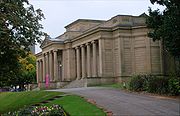 |
1887 | Flockton & Gibbs |
| The Mount The Mount, Sheffield The Mount is a Grade II* listed building situated on Glossop Road in the Broomhill area of Sheffield in England. It stands just over 2 km west of the city centre. It is a neoclassical building which was originally a terrace of eight houses but since the 1950s has been used for commercial office... , Glossop Road |
c. 1830 | William Flockton William Flockton Flockton's were a series of architectural firms in the 19th and early 20th centuries, based in Sheffield, England. The firms were responsible for a number of significant buildings, particularly in the Sheffield area.-William Flockton:... |
|
| Mount Pleasant Community Centre Mount Pleasant, Sheffield Mount Pleasant is an 18th century mansion situated on Sharrow Lane in the Highfield area of the City of Sheffield in South Yorkshire, England. The house stands just under two km south of the city centre and is a grade II* listed building, it has been described as “one of the best 18th century... including former stables and coaching block |
1777 | John Platt | |
| Norton Hall Hospital | |||
| Oaks Park and adjoining structures | |||
| Old Queen's Head Old Queen's Head, Sheffield The Old Queen's Head is a public house on Pond Hill in the City of Sheffield, England that occupies the oldest domestic building in the city. This timber framed building is thought to date from c.1475, although the earliest known written record of it is in an inventory compiled in 1582 of the... |
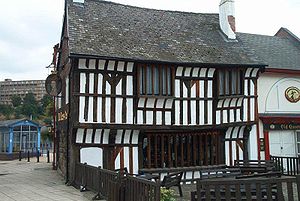 |
c. 1475 | |
| Onesacre Hall Onesacre Hall Onesacre Hall is a Grade II* Listed building situated in the rural outskirts of the City of Sheffield in South Yorkshire, England. The hall is located on Green Lane in the small hamlet of Onesacre in the suburb of Oughtibridge, 8.5 km north west of the city centre.-History:The present Onesacre Hall... |
1630–1670 | John Hawley | |
| Park Hill Flats |  |
1961 | Jack Lynn and Ivor Smith |
| Portland Works Portland Works Portland Works is a former cutlery works in the Highfield area of Sheffield in England. Built in 1877, it is now a Grade II* listed building with a wide variety of cultural uses.- History :The building was constructed in the late 1870s as a cutlery works... |
|||
| St James’ Church, Midhopestones St James’ Church, Midhopestones St James’ Church, Midhopestones is situated in the small rural hamlet of Midhopestones, just within the northern boundary of the City of Sheffield in South Yorkshire. Since April 1969 it has been a Grade II* listed building. St James is small church which is often referred to as a chapel, in fact... |
c. 1360 | ||
| St James, Norton St James, Norton St James' Church lies in the Norton district of Sheffield, South Yorkshire.Although the village of Norton was recorded in the Domesday Book, no church was noted. John Charles Cox believed that the first church in the village was probably founded by Robert FitzRanulph, who also founded nearby... |
|||
| St Mary's Church, Bramall Lane St Mary's Church, Bramall Lane St Mary's Church, Bramall Lane, is a Church of England church in the City of Sheffield, England. It is one of three churches that were built in Sheffield under the Church Building Act 1818 , and is the only one still to be used as a church... |
1830 | Joseph and Robert Potter | |
| St Mary the Virgin, Beighton | |||
| Sanderson Kayser's Darnall Works (two crucible steel Crucible steel Crucible steel describes a number of different techniques for making steel in a crucible. Its manufacture is essentially a refining process which is dependent on preexisting furnace products... shops) |
1871 | ||
| Sharrow Mills |  |
c. 1737 | |
| Sheffield General Cemetery Sheffield General Cemetery The General Cemetery is a cemetery in the City of Sheffield, England that opened in 1836, and closed for burial in 1978. It was the principal cemetery in Victorian Sheffield with over 87,000 burials. Today it is a conservation area , and it is listed on the English Heritage National Register of... (Gatehouse, Egyptian Gate and Non-Conformist Chapel) |
1836 | Samuel Worth | |
| Terminal Warehouse, Victoria Quays Victoria Quays Victoria Quays is a large canal basin in Sheffield, England. It was constructed 1816–1819 as the terminus of the Sheffield Canal and includes the former coal yards of the Manchester, Sheffield and Lincolnshire Railway... |
|||
| University of Sheffield University of Sheffield The University of Sheffield is a research university based in the city of Sheffield in South Yorkshire, England. It is one of the original 'red brick' universities and is a member of the Russell Group of leading research intensive universities... Library and Arts Tower Arts Tower The Arts Tower is a building at 12 Bolsover Street in Sheffield, England belonging to the University of Sheffield and opened in 1966. English Heritage has called it "the most elegant university tower block in Britain of its period... |
1965 | Gollins, Melvin, Ward & Partners | |
| Well Meadow Street Crucible Furnace and attached buildings | |||
| Whitley Hall Hotel | c. 1550s-1580s | Thomas & William Parker | |
| Wicker Arches Wicker Arches The Wicker Arches form a long railway viaduct across the Don Valley in the City of Sheffield, England. They take their name from the thoroughfare The Wicker, which passes through the main arch of the viaduct and was, until the completion of the Sheffield Parkway, the main route eastwards from the... |
1848 | Sir John Fowler John Fowler (engineer) Sir John Fowler, 1st Baronet KCMG LLD was an English civil engineer specialising in the construction of railways and railway infrastructure. In the 1850s and 1860s, he was engineer for the world's first underground railway, London's Metropolitan Railway, built by the "cut-and-cover" method under... |
Grade II
| Building | Date built | Architect |
|---|---|---|
| Abbeydale Picture House Abbeydale Picture House Abbeydale Picture House is a former cinema in the City of Sheffield, England. When opened by the Lord Mayor of Sheffield on 20 December 1920 the picture house was the largest and most luxurious cinema in Sheffield, it was often called Picture Palace because it was decorated in cream and gold with... |
1920 | Dixon and Shenley |
| Former Adelphi Cinema | 1920 | William C. Fenton |
| Almshouse Almshouse Almshouses are charitable housing provided to enable people to live in a particular community... |
||
| Attercliffe Chapel Attercliffe Chapel Attercliffe Chapel, also known as the Hill Top Chapel, is a Gothic chapel in Attercliffe, now a suburb of Sheffield, South Yorkshire, England... |
1629 & 1909 | |
| Botanical Gardens Bear Pit Sheffield Botanical Gardens The Sheffield Botanical Gardens are botanical gardens situated off Ecclesall Road in Sheffield, England, with 5,000 species of plant in 19 acres of land.... |
1836 | |
| Birley Spa Birley Spa Birley Spa is a community bath hall and a Victorian bathhouse in the Hackenthorpe district of the City of Sheffield, England. It was built for Charles Herbert Pierrepont, 2nd Earl Manvers and the Lord of the Manor of Beighton in 1842, and initially was a hotel with spa baths beneath. Subsequently... |
1842 | |
| Botanical Gardens Pavilions Sheffield Botanical Gardens The Sheffield Botanical Gardens are botanical gardens situated off Ecclesall Road in Sheffield, England, with 5,000 species of plant in 19 acres of land.... |
1836 | Robert Marnock Robert Marnock Robert Marnock was one of the outstanding horticulturalists and garden designers of the 19th century and was considered by his contemporaries to be the best exponent of the gardenesque school of landscape gardening.... |
| The Britannia Inn, Attercliffe (former home of Benjamin Huntsman Benjamin Huntsman Benjamin Huntsman was an English inventor and manufacturer of cast or crucible steel.-Biography:Huntsman was born the third son of a Quaker farmer in Epworth, Lincolnshire. His parents were Germans who had emigrated only a few years before his birth.Huntsman started business as a clock, lock and... ) |
1772 | |
| Broom Hall Broom Hall Broom Hall is a historic house in the City of Sheffield, England that gives its name to the surrounding Broomhall district of the city. The earliest part of the house is timber-framed; it has been tree-ring dated to c1498, and was built by the de Wickersley family, whose ancestral home was at... |
c.1498-1784 | |
| Broomhill Church Broomhill Church St Mark's Church, Broomhill is the parish church of the Sheffield suburb of Broomhill, in England.The church was originally built in 1868–1871 to a standard neo-Gothic design by W. H. Crossland. This building was destroyed by an incendiary bomb during the "Sheffield Blitz" of 12 December... (west tower and porch) |
1871 | W. H. Crossland |
| Burrowlee House Burrowlee House Burrowlee House is a Georgian style building situated at grid reference on Broughton Road in the Owlerton district of Sheffield, some four km NW of the city centre. It is the oldest building in the Owlerton and Hillsborough area and was one of the first houses constructed wholly from brick in... |
1711 | |
| Carbrook Hall Public House Carbrook Hall Carbrook Hall is a historic house in Sheffield, England. Located at in the Attercliffe district of the city, the original building was owned by the Blunt family from 1176. This was rebuilt in 1462, and was bought by Thomas Bright in the late 16th century... |
c1620 | |
| Carmel House (facade) | 1890 | |
| Cathedral Church of St Marie | 1848 | Matthew Hadfield |
| Cementation furnace Cementation furnace, Sheffield The Cementation furnace in Sheffield, South Yorkshire, England is a Grade II Listed Building and is the only example of this type of steel making furnace to survive intact in Great Britain... , Doncaster Street |
1848 | built for Daniel Doncasters steelworks |
| Cemetery Road Baptist Church | 1839 | |
| Sheffield General Cemetery Sheffield General Cemetery The General Cemetery is a cemetery in the City of Sheffield, England that opened in 1836, and closed for burial in 1978. It was the principal cemetery in Victorian Sheffield with over 87,000 burials. Today it is a conservation area , and it is listed on the English Heritage National Register of... (Anglican Chapel, Registrar's House, & various monuments) |
1836–1880 | Samuel Worth, William Flockton William Flockton Flockton's were a series of architectural firms in the 19th and early 20th centuries, based in Sheffield, England. The firms were responsible for a number of significant buildings, particularly in the Sheffield area.-William Flockton:... , and others |
| Crucible Theatre Crucible Theatre The Crucible Theatre is a theatre built in 1971 and located in the city centre of Sheffield, South Yorkshire, England. As well as theatrical performances, it is home to the most important event in professional snooker, the World Snooker Championship.... |
1971 | |
| Fulwood Old Chapel Fulwood Old Chapel Fulwood Old Chapel is a Unitarian place of worship in the Fulwood district of western Sheffield, South Yorkshire. It is a member of the General Assembly of Unitarian and Free Christian Churches, the umbrella organisation for British Unitarians.... |
1729 | |
| Gell Street Pavilion | 1830s | |
| Hallfield House Hallfield House Hallfield House is a Grade II listed building situated in Bradfield Dale, west of the village of Low Bradfield, near Sheffield in England.-History:... |
mid-17th century | |
| Heeley Tramway Depot Sheffield Tramway Sheffield Tramway was an extensive tramway network serving the English city of Sheffield and its suburbs.The first tramway line, horse-drawn, opened in 1873 between Lady's Bridge and Attercliffe, subsequently extended to Brightside and Tinsley... |
1878 | |
| Head Post Office Building, Fitzalan Square Fitzalan Square Fitzalan Square is a municipal square situated in the city centre of Sheffield in South Yorkshire, England. The present day square is one of the busiest areas of the city centre with traffic and pedestrians continually moving through the area... |
1893 & 1910 | J. Williams |
| Hillsborough House Hillsborough House Hillsborough House, later called Hillsborough Hall is a large stone built mansion built in the Adam style in the latter part of the 18th century. It stands 2½ miles NW of the centre of Sheffield at grid reference in the suburb of Hillsborough within Hillsborough Park, a council owned public... |
1779 | |
| King Edward VII Hospital King Edward VII Orthopaedic Hospital, Sheffield The King Edward VII Orthopaedic Hospital is a former hospital in the Rivelin Valley area of Sheffield, England. The hospital closed in 1992 and the building has been converted into residential apartments.... , Rivelin (Now converted to apartments) |
1916 | W.A. Kenyon |
| Loxley House Loxley House Loxley House is a Georgian building situated off Ben Lane in the Wadsley area of Sheffield in South Yorkshire, England. It is a Grade Two Listed building.-History:... |
1826 | |
| Monument to Thomas Wiley | 1853 | |
| 97–117 Norfolk Street (including the Brown Bear public house) | late 18th century–1875 | |
| Old Bank House Old Bank House Old Bank House is the oldest surviving brick-built house in Sheffield City Centre in South Yorkshire, England. It lies on Hartshead, north of the High Street.... , Hartshead |
1728 | |
| Oughtibridge railway station Oughty Bridge railway station Oughty Bridge railway station was a railway station on the Sheffield, Ashton-under-Lyne and Manchester Railway built to serve the village of Oughtibridge, near Sheffield, South Yorkshire.... , |
1845 | |
| Our Lady & St Thomas Church | 1933 | M.J Gleeson |
| Sacred Heart Church, Hillsborough Sacred Heart Church, Hillsborough Sacred Heart Church is located in Forbes Road in the Hillsborough district of the city of Sheffield, South Yorkshire, England at . It is a Roman Catholic church in the Diocese of Hallam and is a Grade II listed building... |
1936 | C.M. Hadfield |
| Sheffield Castle Sheffield Castle Sheffield Castle was a castle in Sheffield, England, constructed at the confluence of the River Sheaf and the River Don, possibly on the site of a former Anglo-Saxon long house, and dominating the early town. A motte and bailey castle had been constructed on the site at some time in the century... |
c1270 | |
| Sheffield United Gas Light Company Offices Sheffield United Gas Light Company Offices The former Sheffield United Gas Light Company Offices is a Grade II listed building situated on the northern side of Commercial Street in the centre of the City of Sheffield, South Yorkshire, England. It was originally known as Panache House and this is carved above the western doorway of the... |
1875 | M. E. Hadfield & Son |
| Shepherd Wheel Shepherd Wheel Shepherd Wheel is a working museum in a former water-powered grinding workshop situated on the Porter Brook in the south-west of the City of Sheffield, England. One of the earliest wheels on the River Porter, it is one of the few remaining—and effectively complete—examples of this kind of... |
c. 1780 | |
| Sir Frederick Mappin Building Sir Frederick Mappin Building The Sir Frederick Mappin Building, or more familiarly, the Mappin Building, is a grade II-listed building on Mappin Street, Sheffield, England, named after Sir Frederick Mappin , the so-called Father of Sheffield University.... |
||
| St George's Church, Portobello St George's Church, Portobello St George's Church, Portobello was a Church of England church in the City of Sheffield, England. It is now part of the University of Sheffield and functions as a lecture theatre and student housing.... |
1825 | Woodhead & Hurst |
| St John's Church, Ranmoor St John's Church, Ranmoor St John's Church, Ranmoor is a large parish church in Ranmoor, a suburb of the City of Sheffield, England. It is a Church of England church in the Diocese of Sheffield, and it is the second church to be built on this site. The original church, designed by E.M. Gibbs, was opened 24 April 1879... |
1888 | Flockton & Gibbs |
| St Mary's Church, Bolsterstone St Mary's Church, Bolsterstone St Mary’s Church, Bolsterstone is situated in the village of Bolsterstone, within the boundary of the City of Sheffield in South Yorkshire, England. The church dates from 1879 although there is evidence that a place of worship has existed on the site since the 12th century... |
1879 | John Brearley |
| St Matthew's Church St Matthew's Church, Sheffield St Matthew's Church is situated on Carver Street in the centre of Sheffield. It is a Grade II listed building located at grid reference . The church is part of the Anglo-Catholic movement.-History:... , Carver Street |
1855 | Flockton & Sons William Flockton Flockton's were a series of architectural firms in the 19th and early 20th centuries, based in Sheffield, England. The firms were responsible for a number of significant buildings, particularly in the Sheffield area.-William Flockton:... |
| St Michael's Cemetery St Michael's Cemetery, Sheffield St Michael’s Cemetery is a Catholic burial ground in the Rivelin Valley area of Sheffield, South Yorkshire, England. The cemetery stands on a steep hillside on the south side of Rivelin Valley Road at its junction with Rivelin Road and Hollins Lane.-History:... , Rivelin (Chapel and Walsh memorial) |
1877 | Messrs Hadfield and Son Matthew Ellison Hadfield Matthew Ellison Hadfield was an English architect of the Victorian Gothic revival. He is chiefly known for his work on Roman Catholic churches, including the cathedral churches of Salford and Sheffield.-Training:... |
| St Paul's Church, Wordsworth Avenue St Paul's Church, Wordsworth Avenue St Paul’s Church is situated within the English city of Sheffield on Wordsworth Avenue in the northern suburb of Parson Cross. St Paul’s is a modern looking post war church which has been designated as a Grade II listed building.-History:... |
1959 | Basil Spence Basil Spence Sir Basil Urwin Spence, OM, OBE, RA was a Scottish architect, most notably associated with Coventry Cathedral in England and the Beehive in New Zealand, but also responsible for numerous other buildings in the Modernist/Brutalist style.-Training:Spence was born in Bombay, India, the son of Urwin... |
| Statue of King Edward VII, Fitzalan Square Fitzalan Square Fitzalan Square is a municipal square situated in the city centre of Sheffield in South Yorkshire, England. The present day square is one of the busiest areas of the city centre with traffic and pedestrians continually moving through the area... |
1913 | Alfred Drury Alfred Drury Alfred Briscoe Drury, was an English architectural sculptor and figure in the New Sculpture movement.Born in London, Drury studied under Edouard Lanteri and Jules Dalou, with whom he worked between 1881 and 1885, and then became assistant to Joseph Boehm.Drury is best represented at the Victoria... |
| Tapton Hall Tapton Hall Tapton Hall is a Grade II listed building situated on Shore Lane in the Crosspool area of Sheffield, England.-History:The present day Tapton Hall was built in 1855, however a building known as Tapton House existed on the site before that... |
1855 | Flockton & Son |
| Taylor's Eye Witness | 1836 | |
| Tinsley Park Cemetery Tinsley Park Cemetery Tinsley Park Cemetery is one of the city of Sheffield's many cemeteries. It was opened in 1882, and covers . The cemetery is still open to burials, and since the first burial on 2 June 1882 over 59,000 burials have taken place.... |
1882 | |
| Drama Studio, University of Sheffield Drama Studio, University of Sheffield The Drama Studio is a 218-seat studio theatre that is part of the University of Sheffield. It is housed in the former Glossop Road Baptist Church , which was converted into a theatre in 1970 and also houses two rehearsal studios and other production facilities.It has been at the centre of the... |
1869 | C.J. Innocent |
| Upper Chapel Upper Chapel Upper Chapel is a Unitarian chapel lying on Norfolk Street in Sheffield City Centre. It is a member of the General Assembly of Unitarian and Free Christian Churches, the umbrella organisation for British Unitarians.... |
1700, 1848 | John Frith |
| Victoria Hall Victoria Hall, Sheffield Victoria Hall is a Methodist place of worship situated on Norfolk Street in Sheffield city centre. It is the most important Methodist building in Sheffield and it is a Grade II listed building. It is a large many roomed building which stands between the side streets of Chapel Walk and George Street... |
1908 | Waddington Son & Dunkerley / W.J Hale |
| Victoria Quays Victoria Quays Victoria Quays is a large canal basin in Sheffield, England. It was constructed 1816–1819 as the terminus of the Sheffield Canal and includes the former coal yards of the Manchester, Sheffield and Lincolnshire Railway... (various buildings) |
1819–1900 | |
| Wadsley Parish Church Wadsley Parish Church Wadsley Parish Church is situated within the city of Sheffield, South Yorkshire, it is located on Worrall Road, north west of the city centre in the suburb of Wadsley, which was formerly a village outside the city boundary. The church is quite unusual in that it is not dedicated to a saint... |
1834 | |
| The White Building, Fitzalan Square Fitzalan Square Fitzalan Square is a municipal square situated in the city centre of Sheffield in South Yorkshire, England. The present day square is one of the busiest areas of the city centre with traffic and pedestrians continually moving through the area... |
1908 | Gibbs & Flockton |
See also
- Grade I listed buildings in South YorkshireGrade I listed buildings in South YorkshireThere are 62 Grade I listed buildings in South Yorkshire, England. In the United Kingdom, the term listed building refers to a building or other structure officially designated as being of special architectural, historical or cultural significance; Grade I structures are those considered to be...
- Listed buildings in Sheffield City Centre

